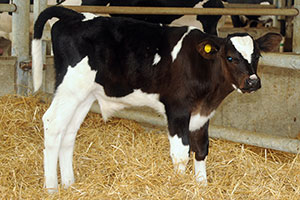 Good barn ventilation is an important contributor to the health and welfare of calves. Natural or mechanical ventilation systems can help keep air circulating, but which system is best for a particular farm best depends on many factors, including a facility’s age and size, and the number and size of animals it houses.
Good barn ventilation is an important contributor to the health and welfare of calves. Natural or mechanical ventilation systems can help keep air circulating, but which system is best for a particular farm best depends on many factors, including a facility’s age and size, and the number and size of animals it houses.
“In the winter, maintaining body temperature for calves is critical. They don’t produce as much heat as larger animals and they are very susceptible to drafts,” explains Rajan Niraula, Dairy and Beef Engineer with the Ontario Ministry of Agriculture, Food and Rural Affairs (OMAFRA). “And in the summer, we need more exchange of air in the barn because of the hotter temperatures.”
Recommended ventilation rates for calves:
| Calf weight kg(lb) |
Minimum CFM*/calf |
Maximum CFM*/calf |
| 45 (100) |
10 |
40 |
| 70 (155) |
15 |
60 |
| 120 (265) |
26 |
105 |
| 170 (375) |
38 |
150 |
| 250 (550) |
55 |
220 |
| 300 (660) |
66 |
265 |
*CFM = cubic feet per minute
Source: http://www.omafra.gov.on.ca/english/livestock/beef/facts/06-083.htm#housing
Fans are selected based on how much air they can move, measured in cubic feet per minute (CFM).
Farmers can determine the capacity of the fans they’ll need by doing some calculations based on parameters like the number of animals they’re housing, the minimum and maximum weight of those animals, and the minimum and maximum ventilation rates for animals at various weights.
For example, a 15-head continuous flow calf room (50 ft x 12 ft x 8 ft or 15.24 m x 3.65 m x 2.43 m ) housing animals with a minimum weight of 57 kilograms or 125 pounds (considered small calf) and a maximum weight of 114 kg or 251 pounds (considered large calf) would require:
- a minimum cold weather ventilation rate of 320 CFM (based on four air changes per hour)
- a minimum cold weather rate for small calves of 150 CFM (10 CFM x 15 small calves) and 180 CFM for large calves (12 CFM x 15 calves)
- a maximum warm weather rate of 2400 CFM (based on an air change every two minutes) or
- a maximum warm weather rate of 3000 CFM (based on maximum rate of 200 CFM per calf)
Stage 1 is referred to as the minimum ventilation rate and in most circumstances, is controlled so it never turns off.
If a variable stage fan is to be considered in Stage 1, its maximum capacity is chosen on the basis of its flow rate being two to three times larger than the minimum exchange rate required: hence, maximum capacity of the Stage 1 variable fan is 450 CFM (150 x 3) for small calves and 360 CFM (180 x 2) for large calves.
Based on above calculations, the minimum air flow rate for this example ranges between 320 CFM and 450 CFM, making a variable speed fan with a minimum air flow range of 320-450 CFM a good choice for Stage 1 ventilation in this example.
It’s important to note that once Stage 1 ventilation is operating at full speed due to warmer room temperature, any additional increase in temperatures requires that a Stage 2 fan turns on. A good variable speed fan choice for this stage has a range of 1200 to 2400 CFM.
Other considerations for good ventilation and air quality:
- Keep calves out of drafts. The combination of speed, temperature, and humidity of the air will stress calves and make them susceptible to diseases like pneumonia.
- Calves don’t provide enough body heat to encourage natural air movement so it’s important to ensure fresh air is distributed evenly in the calf room or barn.
- Keep calves clean and dry, with plenty of dry bedding for warmth. This ensures they’ll put their energy into growth rather than trying to stay warm.
- A “warm” calf barn has an insulated ceiling and walls with added heat. The goal is to keep the room temperature between 10 and 13 C (50 to 86 F), and although these buildings can be naturally ventilated, fan ventilation is more common.
- A “cold” calf barn is naturally ventilated using adjustable curtains for sidewall ventilation. Shade cloth should be added to the top 12 to 18 inches (30 – 45 cm) of wall opening to slow down incoming air during cooler weather and reduce the potential for drafts.
More information about ventilating for veal calves is available at http://159.89.120.83/housing/ventilation/.
 Good barn ventilation is an important contributor to the health and welfare of calves. Natural or mechanical ventilation systems can help keep air circulating, but which system is best for a particular farm best depends on many factors, including a facility’s age and size, and the number and size of animals it houses.
Good barn ventilation is an important contributor to the health and welfare of calves. Natural or mechanical ventilation systems can help keep air circulating, but which system is best for a particular farm best depends on many factors, including a facility’s age and size, and the number and size of animals it houses.